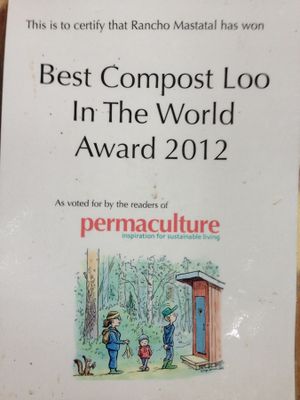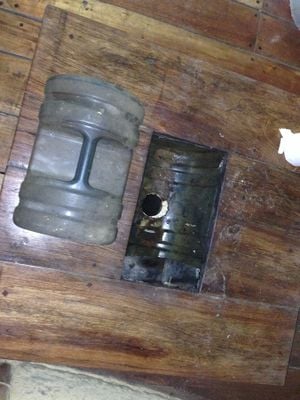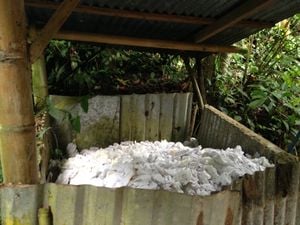

Rancho Mastatal in Costa Rica has an award winning floating drum biodigester toilet. Jose Luis Zuñiga of Rancho Montezumo, a coffee producing ranch near Puriscal, Costa Rica, helped Rancho Mastatal with the design and construction of the biodigester. The biodigester processes human fecal waste in an anaerobic environment, and its byproducts are compost and methane. The compost deposits into the forest below the biodigester, and the methane is fed to the main house kitchen where it is used to cook food.
Components[edit | edit source]
The table below describes the various components that make the biodigester toilet work.
| Image | Description |
|---|---|
 |
This is the floating drum biodigester. It was constructed with a concrete exterior tank and a 6 foot fiberglass bell. The internal wall is made from red brick. Two toilets feed the biodigester. If the toilets do not produce enough material then a manure and water solution is also be fed into the biodigester. The manure solution comes from this project: Rancho Mastatal manure biodigester. |
  |
One of the toilets is a squating toilet. Squatting to defecate is less strenuous on the body. The squatting toilet was made by cutting a 5 gallon water jug in half length-wise and using one half for the toilet basin, and the other half for the lid. The toilet is flushed by filling a bucket with water and manually pouring the water in the toilet basin. |
 |
The other toilet is a sitting toilet for "conventional" pooping. It is flushed by turning on the water to a hose that is inserted inside the toilet bowl. |
 |
Both of the toilets flush into a brick tank that serves as an access point to the system before the biodigester. The fecal material and water then flows from the brick tank to the biodigester. |
 |
Toilet paper can not be put into the biodigester, but it can be composted. This is a compost pile for the toilet paper used through regular biodigester toilet use. |
 |
While the waste material is being digested anaerobically it produces methane gas. The methane gas is collected and fed through a brillow pad scrub to eliminate toxic sulfur dioxide. It then goes to the main house kitchen, where it is used to cook food. |
 |
The hand washing sink is a good example of how broken tiles can be used to make aesthetically pleasing and practical structures. The water from the sink flows into the forest below. |
 |
This broken loop artwork created by Maudie Johnson displays a representation of "conventional" toilet systems. Explanation from bottom left clockwise: energy intensive industry fertilizers are used to produce food, which is then turned into poop, a waste product that creates pollution. |
 |
This closed loop artwork created by Maudie Johnson displays a representation of the biodigester toilet system. Explanation from left clockwise: Food is eaten and turned into poop. Poop is flushed into the biodigester, where it is processed into compost and fuel. The compost grows more food, and the fuel cooks the food before it is eaten, continuing the cycle. |